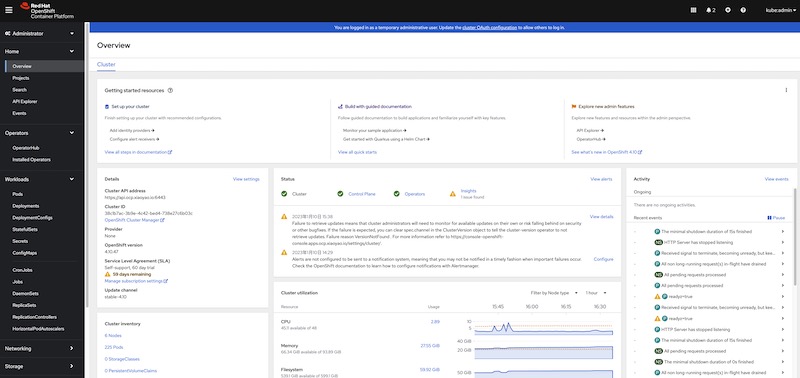In this tutorial, i will describe how to install and setup an openshift container platform (OCP) 4.10 cluster with high available architecture manually. This is a step by step guide for installing an OpenShift 4 cluster with high availability, and i will try my best to describe it as clearly as i can. This installation will use connected network to pull images online, for disconnected or offline installation, i will describe it later. The virtual machines used will be manually provisioned in vmware esxi platform. For high availability, a load balancer should be available, i will use haproxy as a soft load balancer, for enterprise or production case, use f5 or others instead, all operatoions performed bellow are as root user, okay, let’s start.
Environment Summary of OpenShift 4 high available installation
This environment and setup can be used as a dev or stage environment, for production environment, load balancer and dns service should also be high available, infra nodes and ingress nodes should be seperated. These machines do not need to be ready at this time, setup each one following the steps described bellow.
Node list
| Role | IP | Hostname | Note |
|---|---|---|---|
| Control plane | 192.168.1.21 | master0.ocp.xiaoyao.io | 8c/16G/100G disk |
| Control plane | 192.168.1.22 | master1.ocp.xiaoyao.io | 8c/16G/100G disk |
| Control plane | 192.168.1.23 | master2.ocp.xiaoyao.io | 8c/16G/100G disk |
| Worker/Ingress | 192.168.1.24 | worker0.ocp.xiaoyao.io | 8c/16G/100G disk |
| Worker/Ingress | 192.168.1.25 | worker1.ocp.xiaoyao.io | 8c/16G/100G disk |
| Bastion/LB | 192.168.1.8 | bastion.ocp.xiaoyao.io | 4c/8G/100G disk |
| Bootstrap | 192.168.1.20 | bootstrap.ocp.xiaoyao.io | 8c/16G/100G disk |
Note
the bootstrap node can be removed when the cluster is up
Cluster Setting
Base Domain: xiaoyao.io
Cluster name: ocp
Route sub domain: *.apps.ocp.xiaoyao.io, dns server resolv this doamin to lb node, and haproxy dispatch traffic from 80 and 443 to ingress nodes.
Ingress nodes: worker0.ocp.xiaoyao.io, worker1.ocp.xiaoyao.io
OpenShift Version: 4.10.47
Coreos Version: 4.10.37
Install Bastion Server
We need a bastion server for some services such as load balance, webserver, dns service. if you are in offline installation mode, an image registry should also be deployed. A bastion server do not need high quota resources, 4core 8G memory, 100G disk space is enough. On this server, we generate and store installation files, centos stream 8 is base os with minimal installation, hostname is bastion.ocp.xiaoyao.io, with static ip 192.168.1.8, dns server: 114.114.114.114.
Prepare Server
Disable firewall and selinux, for production, this server will be removed after cluster is up. for dev purpose, these services are disabled, and you can keep bastion server alive, for other version’s try out.
# systemctl stop firewalld
# systemctl disable firewalld
# setenforce 0
# vi /etc/selinux/config
SELINUX=disabled
SELINUXTYPE=targetedobtain installation binary, download specifc openshift install client from here
# dnf install -y wget
# wget https://mirror.openshift.com/pub/openshift-v4/x86_64/clients/ocp/4.10.47/openshift-install-linux-4.10.47.tar.gz
# tar zxf openshift-install-linux-4.10.47.tar.gz
# mv openshift-install /usr/local/bin/Download coreos iso image from here and upload it to your esxi datastore. Creating vm from this iso in later steps.
Download image pull secret file from here, if you do not have an account, register one, and save it in /root/pull-secret.txt.
Download openshift clients binary from here, this file contains oc and kubectl command line tools.
# wget https://mirror.openshift.com/pub/openshift-v4/x86_64/clients/ocp/4.10.47/openshift-client-linux-4.10.47.tar.gz
# tar zxf openshift-client-linux-4.10.47.tar.gz
# mv oc /usr/local/bin/
# mv kubectl /usr/local/bin/Setup DNS Service
I use named for dns resolution, install and configure named on bastion server. if you are in public cloud infrastructure, such as aws, azure or gcp, use the dns service provided by them.
# dnf install -y bind bind-utils
# vi /etc/named.conf
listen-on port 53 { any; };
allow-query { 0.0.0.0/0; };
dnssec-enable no;
dnssec-validation no;
# systemctl enable named
# systemctl start namedsetup cluster nodes and api domain resolution, add a custom zone in file /etc/named.rfc1912.zones
# vi /etc/named.rfc1912.zones
zone "ocp.xiaoyao.io" IN {
type master;
file "ocp.xiaoyao.io";
allow-update { none; };
allow-query { any; };
allow-transfer { none; };
};
// create file ocp.xiaoyao.io in /var/named/
# vi /var/named/ocp.xiaoyao.io
$TTL 1W
@ IN SOA ocp.xiaoyao.io. root (
2019070700 ; serial
3H ; refresh (3 hours)
30M ; retry (30 minutes)
2W ; expiry (2 weeks)
1W ) ; minimum (1 week)
IN NS ns1.ocp.xiaoyao.io.
IN MX 10 smtp.ocp.xiaoyao.io.
;
;
ns1.ocp.xiaoyao.io. IN A 192.168.1.8
smtp.ocp.xiaoyao.io. IN A 192.168.1.8
;
bastion.ocp.xiaoyao.io. IN A 192.168.1.8
;
api.ocp.xiaoyao.io. IN A 192.168.1.8
api-int.ocp.xiaoyao.io. IN A 192.168.1.8
;
*.apps.ocp.xiaoyao.io. IN A 192.168.1.8
;
bootstrap.ocp.xiaoyao.io. IN A 192.168.1.20
;
master0.ocp.xiaoyao.io. IN A 192.168.1.21
master1.ocp.xiaoyao.io. IN A 192.168.1.22
master2.ocp.xiaoyao.io. IN A 192.168.1.23
;
worker0.ocp.xiaoyao.io. IN A 192.168.1.24
worker1.ocp.xiaoyao.io. IN A 192.168.1.25
;
# systemctl restart namedAdd reverse dns resolution, these are also needed for cluster installation,
# vi /etc/named.rfc1912.zones
zone "1.168.192.in-addr.arpa" {
type master;
file "1.168.192.in-addr.arpa.zone";
allow-query { any; };
allow-transfer { none; };
allow-update { none; };
};
// create file 1.168.192.in-addr.arpa.zone in /var/named/
# vi /var/named/1.168.192.in-addr.arpa.zone
$TTL 1W
@ IN SOA ocp.xiaoyao.io. root (
2019070700 ; serial
3H ; refresh (3 hours)
30M ; retry (30 minutes)
2W ; expiry (2 weeks)
1W ) ; minimum (1 week)
IN NS ocp.xiaoyao.io.
;
8.1.168.192.in-addr.arpa. IN PTR api.ocp.xiaoyao.io.
8.1.168.192.in-addr.arpa. IN PTR api-int.ocp.xiaoyao.io.
;
20.1.168.192.in-addr.arpa. IN PTR bootstrap.ocp.xiaoyao.io.
;
21.1.168.192.in-addr.arpa. IN PTR master0.ocp.xiaoyao.io.
22.1.168.192.in-addr.arpa. IN PTR master1.ocp.xiaoyao.io.
23.1.168.192.in-addr.arpa. IN PTR master2.ocp.xiaoyao.io.
;
24.1.168.192.in-addr.arpa. IN PTR worker0.ocp.xiaoyao.io.
25.1.168.192.in-addr.arpa. IN PTR worker1.ocp.xiaoyao.io.
;
;EOFTo confirm dns server working fine, take a nslookup query on bastion server
# nslookup api.ocp.xiaoyao.io 127.0.0.1
Server: 127.0.0.1
Address: 127.0.0.1#53
Name: api.ocp.xiaoyao.io
Address: 192.168.1.8
# dig +noall +answer @192.168.1.8 -x 192.168.1.8
8.1.168.192.in-addr.arpa. 604800 IN PTR api-int.ocp.xiaoyao.io.
8.1.168.192.in-addr.arpa. 604800 IN PTR api.ocp.xiaoyao.io.Setup Load Balance Service
I use haproxy as load balance service, if you are in public cloud environment, use the load balance service provided by them. For enterprise production environment, F5 or other high available load balancer is recommended. Install and setup haproxy
# dnf install -y haproxy
# vi /etc/haproxy/haproxy.cfg
global
log 127.0.0.1 local2
pidfile /var/run/haproxy.pid
maxconn 4000
daemon
defaults
mode http
log global
option dontlognull
option http-server-close
option redispatch
retries 3
timeout http-request 10s
timeout queue 1m
timeout connect 10s
timeout client 1m
timeout server 1m
timeout http-keep-alive 10s
timeout check 10s
maxconn 3000
frontend stats
bind *:1936
mode http
log global
maxconn 10
stats enable
stats hide-version
stats refresh 30s
stats show-node
stats show-desc Stats for ocp4 cluster
stats auth admin:ocp4
stats uri /stats
listen api-server-6443
bind *:6443
mode tcp
server bootstrap bootstrap.ocp.xiaoyao.io:6443 check inter 1s backup
server master0 master0.ocp.xiaoyao.io:6443 check inter 1s
server master1 master1.ocp.xiaoyao.io:6443 check inter 1s
server master2 master2.ocp.xiaoyao.io:6443 check inter 1s
listen machine-config-server-22623
bind *:22623
mode tcp
server bootstrap bootstrap.ocp.xiaoyao.io:22623 check inter 1s backup
server master0 master0.ocp.xiaoyao.io:22623 check inter 1s
server master1 master1.ocp.xiaoyao.io:22623 check inter 1s
server master2 master2.ocp.xiaoyao.io:22623 check inter 1s
listen ingress-router-443
bind *:443
mode tcp
balance source
server worker0 worker0.ocp.xiaoyao.io:443 check inter 1s
server worker1 worker1.ocp.xiaoyao.io:443 check inter 1s
listen ingress-router-80
bind *:80
mode tcp
balance source
server worker0 worker0.ocp.xiaoyao.io:80 check inter 1s
server worker1 worker1.ocp.xiaoyao.io:80 check inter 1sat this time, haproxy cannot resolv node address and hostname, add temporary entry in /etc/hosts file, also, you can set ip address in haproxy configuration file instead of node hostname, then the following entries are not needed.
# vi /etc/hosts
192.168.1.20 bootstrap.ocp.xiaoyao.io
192.168.1.21 master0.ocp.xiaoyao.io
192.168.1.22 master1.ocp.xiaoyao.io
192.168.1.23 master2.ocp.xiaoyao.io
192.168.1.24 worker0.ocp.xiaoyao.io
192.168.1.25 worker1.ocp.xiaoyao.iostart haproxy service
# systemctl enable haproxy
# systemctl start haproxySetup Web Server
A temporary web server is needed for store installation files, i use nginx, setup nginx to listen on port 8080, since 80 is used by haproxy.
# dnf install -y nginx
# vi /etc/nginx/nginx.conf
listen 8080 default_server;
listen [::]:8080 default_server;
# systemctl enable nginx
# systemctl start nginxGenerate installation files
Generate ignition files
create install-config.yaml file, install-config.yaml is important and should be saved for later reuse. an ssh public key is needed to ssh login to cluster nodes later, i use bastion node ssh public key, generate an key paire first, and paste public key in install-config.yaml file
# ssh-keygen -t rsa
press enter always
# cat .ssh/id_rsa.pub
copy the public key
# vi install-config.yaml
apiVersion: v1
baseDomain: xiaoyao.io
compute:
- hyperthreading: Enabled
name: worker
replicas: 0
controlPlane:
hyperthreading: Enabled
name: master
replicas: 3
metadata:
name: ocp
networking:
clusterNetwork:
- cidr: 10.128.0.0/14
hostPrefix: 23
networkType: OpenShiftSDN
serviceNetwork:
- 172.30.0.0/16
platform:
none: {}
fips: false
pullSecret: 'contents of file /root/pull-secret.txt'
sshKey: 'ssh-rsa AAAAB3NzV.... root@bastion.ocp.xiaoyao.io'Note
For offline installation, registry configuration and certificates configuration should also be included in install-config.yaml, we do not cover it here.
generate installation ignition files
# mkdir ocp && cd ocp
# cp ../install-config.yaml .
# openshift-install create manifests --dir .
INFO Consuming Install Config from target directory
WARNING Making control-plane schedulable by setting MastersSchedulable to true for Scheduler cluster settings
INFO Manifests created in: manifests and openshiftNote
if you wants to customize the partition of nodes, update manifests file here in openshift directory, we do not cover it here.
# openshift-install create ignition-configs --dir=.
INFO Consuming Openshift Manifests from target directory
INFO Consuming Worker Machines from target directory
INFO Consuming Master Machines from target directory
INFO Consuming OpenShift Install (Manifests) from target directory
INFO Consuming Common Manifests from target directory
INFO Ignition-Configs created in: . and authcopy the ignition files into web server root directory,
# cp *.ign /usr/share/nginx/html/
# chmod o+r /usr/share/nginx/html/*.ign
// perform curl test
# curl -v http://192.168.1.8:8080/bootstrap.ignInstall Bootstrap Server
On bastion node, create and save bootstrap.sh file
# vi /usr/share/nginx/html/bootstrap.sh
coreos-installer install --append-karg 'ip= 192.168.1.20::192.168.1.1:255.255.255.0:bootstrap.ocp.xiaoyao.io:eno5:none nameserver=192.168.1.8' --insecure-ignition --ignition-url=http://192.168.1.8:8080/bootstrap.ign /dev/sda
# chmod o+r /usr/share/nginx/html/bootstrap.sh
Note
configure networking parameters in command line by providing –append-karg paramters to core-installer, the format of these parameters , ip::gateway:netmask:hostname:interface:dhcp
Create the bootstrap server and boot it from coreos iso downloaded before. and enter into a live shell, run the following command to start installatoin
# sudo -i
# curl http://192.168.1.8:8080/bootstrap.sh | bash
When writing disk completed, enter reboot to reboot bootstrap server.
Install Master Nodes
On bastion node, create and save master bash file for master0, master1, and master2, update the ip address and hostname for each one.
# vi /usr/share/nginx/html/master0.sh
#!/bin/bash
coreos-installer install --append-karg 'ip=192.168.1.21::192.168.1.1:255.255.255.0:master0.ocp.xiaoyao.io:ens192:none nameserver=192.168.1.8' --insecure-ignition --ignition-url=http://192.168.1.8:8080/master.ign /dev/sda
# chmod o+r /usr/share/nginx/html/master0.sh
# vi /usr/share/nginx/html/master1.sh
#!/bin/bash
coreos-installer install --append-karg 'ip=192.168.1.22::192.168.1.1:255.255.255.0:master1.ocp.xiaoyao.io:ens192:none nameserver=192.168.1.8' --insecure-ignition --ignition-url=http://192.168.1.8:8080/master.ign /dev/sda
# chmod o+r /usr/share/nginx/html/master1.sh
# vi /usr/share/nginx/html/master2.sh
#!/bin/bash
coreos-installer install --append-karg 'ip=192.168.1.23::192.168.1.1:255.255.255.0:master2.ocp.xiaoyao.io:ens192:none nameserver=192.168.1.8' --insecure-ignition --ignition-url=http://192.168.1.8:8080/master.ign /dev/sda
# chmod o+r /usr/share/nginx/html/master2.sh
Create three master nodes and boot from coreos iso downloaded before, in coreos live shell, run the follwing command,
# sudo -i
# curl http://192.168.1.8:8080/master0.sh | bash
# rebootchange the master0.sh for other master nodes.
Install Worker Nodes
On bastion node, create and save worker bash file for worker0, and worker1, update the ip address and hostname for each one.
# vi /usr/share/nginx/html/worker0.sh
#!/bin/bash
coreos-installer install --append-karg 'ip=192.168.1.24::192.168.1.1:255.255.255.0:worker0.ocp.xiaoyao.io:ens192:none nameserver=192.168.1.8' --insecure-ignition --ignition-url=http://192.168.1.8:8080/worker.ign /dev/sda
# chmod o+r /usr/share/nginx/html/worker0.sh
# vi /usr/share/nginx/html/worker1.sh
#!/bin/bash
coreos-installer install --append-karg 'ip=192.168.1.25::192.168.1.1:255.255.255.0:worker1.ocp.xiaoyao.io:ens192:none nameserver=192.168.1.8' --insecure-ignition --ignition-url=http://192.168.1.8:8080/worker.ign /dev/sda
# chmod o+r /usr/share/nginx/html/worker1.shCreate worker nodes and boot from coreos iso downloaded before, in coreos live shell, run the follwing command,
# sudo -i
# curl http://192.168.1.8:8080/worker0.sh | bash
# rebootchange the worker0.sh for other worker nodes.
Confirm Installation
when all the setup of all nodes are completed, on bastion server, run the following command to confirm
# openshift-install --dir . wait-for bootstrap-complete --log-level=info
INFO Waiting up to 20m0s (until 2:48PM) for the Kubernetes API at https://api.ocp.xiaoyao.io:6443...
INFO API v1.23.12+8a6bfe4 up
INFO Waiting up to 30m0s (until 2:58PM) for bootstrapping to complete...
INFO It is now safe to remove the bootstrap resources
INFO Time elapsed: 1m44s and then comment out the bootstrap node entry in haproxy configuration file, the bootstrap node now can be removed and deleted.
# vi /etc/haproxy/haproxy.cfg
listen api-server-6443
bind *:6443
mode tcp
#server bootstrap bootstrap.ocp.xiaoyao.io:6443 check inter 1s backup
server master0 master0.ocp.xiaoyao.io:6443 check inter 1s
server master1 master1.ocp.xiaoyao.io:6443 check inter 1s
server master2 master2.ocp.xiaoyao.io:6443 check inter 1s
listen machine-config-server-22623
bind *:22623
mode tcp
#server bootstrap bootstrap.ocp.xiaoyao.io:22623 check inter 1s backup
server master0 master0.ocp.xiaoyao.io:22623 check inter 1s
server master1 master1.ocp.xiaoyao.io:22623 check inter 1s
server master2 master2.ocp.xiaoyao.io:22623 check inter 1s
# systemctl reload haproxysetup kubeconfig and oc environment
# mkdir ~/.kube
# cp auth/kubeconfig ~/.kube/configApprove worker node csr, so the worker node can join the cluster.
# oc get csr
NAME AGE SIGNERNAME REQUESTOR REQUESTEDDURATION CONDITION
csr-4dh2x 79m kubernetes.io/kubelet-serving system:node:master0.ocp.xiaoyao.io <none> Approved,Issued
csr-4ls5g 2m kubernetes.io/kube-apiserver-client-kubelet system:serviceaccount:openshift-machine-config-operator:node-bootstrapper <none> Pending
csr-bvtdq 35m kubernetes.io/kube-apiserver-client-kubelet system:serviceaccount:openshift-machine-config-operator:node-bootstrapper <none> Pending
csr-dwlsp 80m kubernetes.io/kube-apiserver-client-kubelet system:serviceaccount:openshift-machine-config-operator:node-bootstrapper <none> Approved,Issued
csr-dxntv 70m kubernetes.io/kubelet-serving system:node:master1.ocp.xiaoyao.io <none> Approved,Issued
csr-fqhnn 68m kubernetes.io/kubelet-serving system:node:master2.ocp.xiaoyao.io <none> Approved,Issued
csr-gldwf 43m kubernetes.io/kube-apiserver-client-kubelet system:serviceaccount:openshift-machine-config-operator:node-bootstrapper <none> Pending
csr-gzr2w 28m kubernetes.io/kube-apiserver-client-kubelet system:serviceaccount:openshift-machine-config-operator:node-bootstrapper <none> Pending
csr-gzzqf 50m kubernetes.io/kube-apiserver-client-kubelet system:serviceaccount:openshift-machine-config-operator:node-bootstrapper <none> Pending
csr-hrwnm 20m kubernetes.io/kube-apiserver-client-kubelet system:serviceaccount:openshift-machine-config-operator:node-bootstrapper <none> Pending
csr-khcf6 70m kubernetes.io/kube-apiserver-client-kubelet system:serviceaccount:openshift-machine-config-operator:node-bootstrapper <none> Approved,Issued
csr-q56rp 13m kubernetes.io/kube-apiserver-client-kubelet system:serviceaccount:openshift-machine-config-operator:node-bootstrapper <none> Pending
csr-stlht 2m25s kubernetes.io/kube-apiserver-client-kubelet system:serviceaccount:openshift-machine-config-operator:node-bootstrapper <none> Pending
csr-wv5xc 5m10s kubernetes.io/kube-apiserver-client-kubelet system:serviceaccount:openshift-machine-config-operator:node-bootstrapper <none> Pending
csr-x8ljb 69m kubernetes.io/kube-apiserver-client-kubelet system:serviceaccount:openshift-machine-config-operator:node-bootstrapper <none> Approved,Issued
system:openshift:openshift-authenticator-77m6h 73m kubernetes.io/kube-apiserver-client system:serviceaccount:openshift-authentication-operator:authentication-operator <none> Approved,Issued
system:openshift:openshift-monitoring-dxc7n 72m kubernetes.io/kube-apiserver-client system:serviceaccount:openshift-monitoring:cluster-monitoring-operator <none> Approved,Issued
# oc get csr -o name | xargs oc adm certificate approve
certificatesigningrequest.certificates.k8s.io/csr-4dh2x approved
certificatesigningrequest.certificates.k8s.io/csr-4ls5g approved
certificatesigningrequest.certificates.k8s.io/csr-bvtdq approved
certificatesigningrequest.certificates.k8s.io/csr-dwlsp approved
certificatesigningrequest.certificates.k8s.io/csr-dxntv approved
certificatesigningrequest.certificates.k8s.io/csr-fqhnn approved
certificatesigningrequest.certificates.k8s.io/csr-gldwf approved
certificatesigningrequest.certificates.k8s.io/csr-gzr2w approved
certificatesigningrequest.certificates.k8s.io/csr-gzzqf approved
certificatesigningrequest.certificates.k8s.io/csr-hrwnm approved
certificatesigningrequest.certificates.k8s.io/csr-khcf6 approved
certificatesigningrequest.certificates.k8s.io/csr-q56rp approved
certificatesigningrequest.certificates.k8s.io/csr-stlht approved
certificatesigningrequest.certificates.k8s.io/csr-wv5xc approved
certificatesigningrequest.certificates.k8s.io/csr-x8ljb approved
certificatesigningrequest.certificates.k8s.io/system:openshift:openshift-authenticator-77m6h approved
certificatesigningrequest.certificates.k8s.io/system:openshift:openshift-monitoring-dxc7n approvedAdjust router pods, if your router pod does not running on worker nodes, mybe in master nodes, use the following methods to specify router pods running on specific nodes, such as ingress nodes. then update default ingresscontroller, add nodeplacement selector.
# oc label node worker0.ocp.xiaoyao.io node-role.kubernetes.io/ingress=''
# oc label node worker1.ocp.xiaoyao.io node-role.kubernetes.io/ingress=''
# oc project openshift-ingress-operator
# oc edit ingresscontroller.operator default
spec:
clientTLS:
clientCA:
name: ""
clientCertificatePolicy: ""
httpCompression: {}
httpEmptyRequestsPolicy: Respond
httpErrorCodePages:
name: ""
nodePlacement:
nodeSelector:
matchLabels:
node-role.kubernetes.io/ingress: ""
tolerations:
- effect: NoSchedule
operator: ExistsConfirm all nodes are in ready state

Confirm all cluster operators are in ready state
# oc get co
NAME VERSION AVAILABLE PROGRESSING DEGRADED SINCE MESSAGE
authentication 4.10.47 True False False 19m
baremetal 4.10.47 True False False 132m
cloud-controller-manager 4.10.47 True False False 138m
cloud-credential 4.10.47 True False False 154m
cluster-autoscaler 4.10.47 True False False 128m
config-operator 4.10.47 True False False 134m
console 4.10.47 True False False 16m
csi-snapshot-controller 4.10.47 True False False 132m
dns 4.10.47 True False False 130m
etcd 4.10.47 True False False 129m
image-registry 4.10.47 True False False 118m
ingress 4.10.47 True False False 123m
insights 4.10.47 True False False 126m
kube-apiserver 4.10.47 True False False 126m
kube-controller-manager 4.10.47 True False False 124m
kube-scheduler 4.10.47 True False False 125m
kube-storage-version-migrator 4.10.47 True False False 131m
machine-api 4.10.47 True False False 127m
machine-approver 4.10.47 True False False 131m
machine-config 4.10.47 True False False 38m
marketplace 4.10.47 True False False 3m13s
monitoring 4.10.47 True False False 120m
network 4.10.47 True False False 135m
node-tuning 4.10.47 True False False 56m
openshift-apiserver 4.10.47 True False False 123m
openshift-controller-manager 4.10.47 True False False 127m
openshift-samples 4.10.47 True False False 121m
operator-lifecycle-manager 4.10.47 True False False 130m
operator-lifecycle-manager-catalog 4.10.47 True False False 130m
operator-lifecycle-manager-packageserver 4.10.47 True False False 123m
service-ca 4.10.47 True False False 133m
storage 4.10.47 True False False 130mkubeadmin password is in /root/ocp/auth/kubeadmin-password
# cat /root/ocp/auth/kubeadmin-passwordlogin to openshift console with user kubeadmin and password above. The is console url is https://console-openshift-console.apps.ocp.xiaoyao.io/




